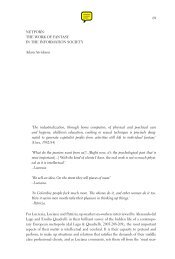Nakamura, Digitizing Race, Introduction, chapter 5, Epilogue
Nakamura, Digitizing Race, Introduction, chapter 5, Epilogue
Nakamura, Digitizing Race, Introduction, chapter 5, Epilogue
You also want an ePaper? Increase the reach of your titles
YUMPU automatically turns print PDFs into web optimized ePapers that Google loves.
156 Avatars and the Visual Culture of Reproduction<br />
miscarried? Would the act of altering or removing that avatar from the<br />
board signify a miscarriage in miniature, a digital reenactment of the offline<br />
state? What are the implications of this participatory digital practice?<br />
In Feminism and the Technological Fix, Carol Stabile describes the defining<br />
paradox of the visual culture of pregnancy as follows: “With the advent of<br />
visual technologies, the contents of the uterus have become demystified<br />
and entirely representable, but pregnant bodies themselves remain concealed.”<br />
31 Hence the paradox: while medical imaging technologies like ultrasounds<br />
and laparoscopy have turned the pregnant female body inside out,<br />
rendering it as transparent as a pane of glass, a vessel containing infinite<br />
visual wonders of procreation and opportunities for witnessing with machineenabled<br />
vision the miracle (or spectacle) of birth, its exterior remains hidden<br />
in plain sight. As Stabile writes: “The pregnant body. . . remains invisible<br />
and undertheorized in feminist theory.” 32 Many other scholars of feminism,<br />
technology, and the visual have noted the pregnant body’s peculiar status in<br />
post-1990s feminist visual culture. As Lisa Cartright writes in “A Cultural<br />
Anatomy of the Visible Human Project,” pregnant bodies have long been<br />
used to stand in for all female bodies in the culture of medical imaging, from<br />
its roots in classically rendered paintings of female pelvises by d’Agoty 33 to<br />
current projects like the Visible Woman, whose cryosectioned body was<br />
digitized and put on a database online for educational purposes. 34 Thus<br />
women’s reproductive organs, and women in reproductive states, are overrepresented<br />
in medical visual culture; the pregnant female body and its<br />
interior in particular is classically overdetermined as it comes to represent<br />
all female bodies. A spate of scholarly books and collections on the topic of<br />
reproductive technologies and feminism have all noted the way that the<br />
medical establishment has worked to make the pregnant female body normative,<br />
and its result, which is to pathologize nonreproductive female bodies—<br />
as Cartright notes, the Visible Woman was criticized as an incomplete and<br />
inadequate model of the female body because, though in perfect health at her<br />
time of death, she is “postmenopausal and presumably therefore unsuited<br />
to demonstrating processes of reproduction.” 35 Ultrasound has taken up the<br />
imaging practice that once belonged to medical painting and engraving and<br />
is valued because it seems to give access to the invisible, the interior, to move<br />
right past the unspeakable and abject pregnant body to its contents, the fetus.<br />
While American culture as a whole is unappeasably eager to see photographic<br />
or “real” images of babies in the womb, pregnancy’s hidden spectacle,<br />
feminists in particular are wary of the way that this desire encourages ways<br />
of seeing that represent the fetus and mother as occupying different visual





